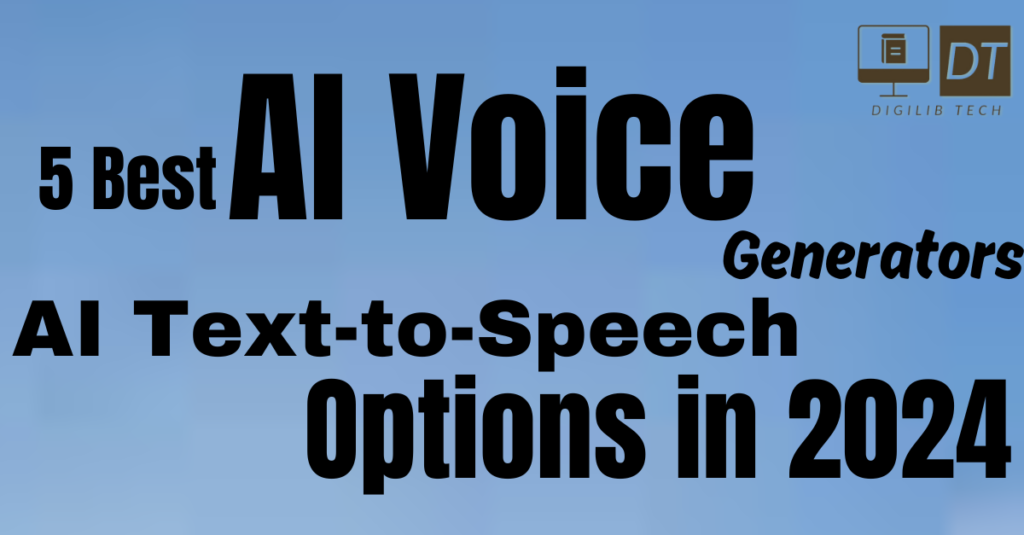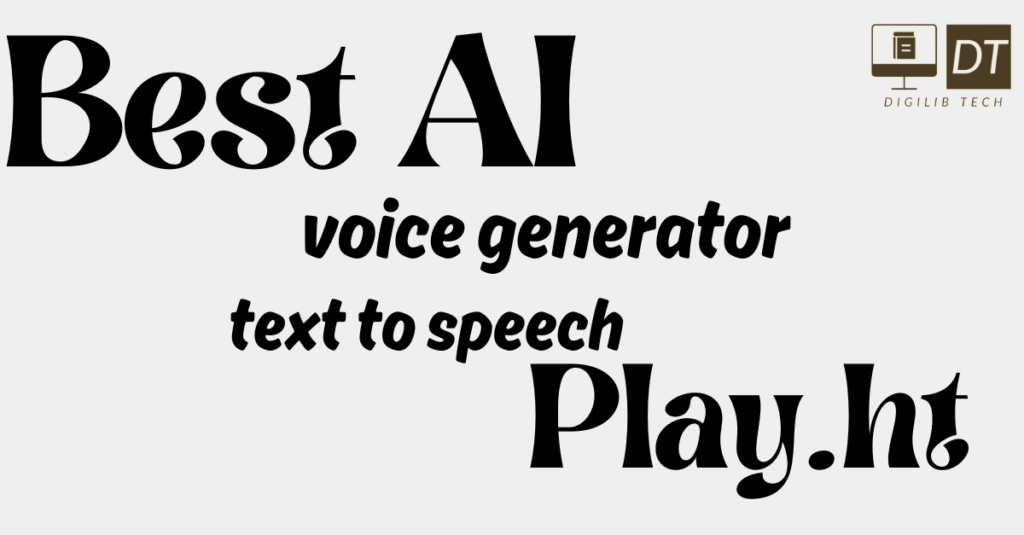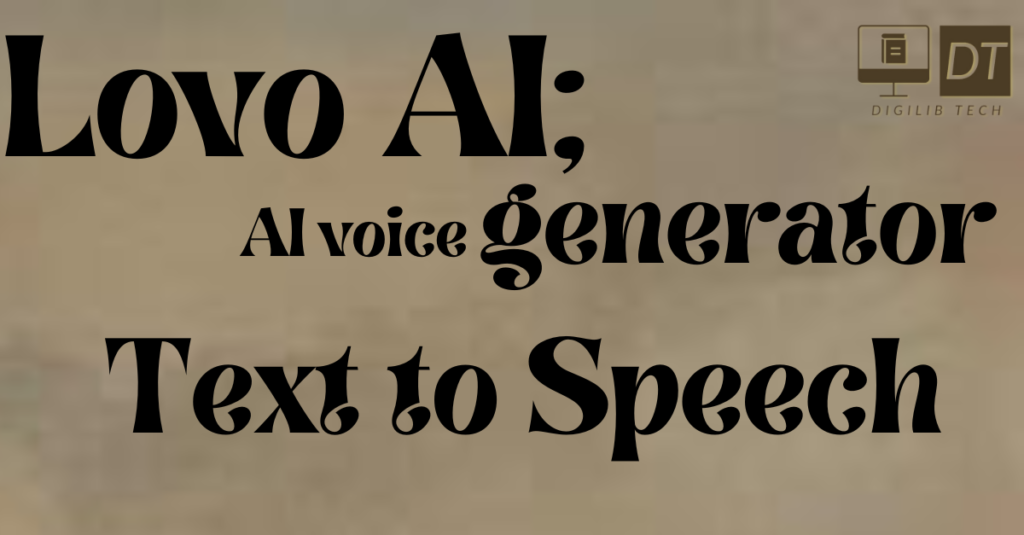Artificial Intelligence (AI) has revolutionised many aspects of modern life, and voice generation technology is no exception. AI voice generators, often referred to as AI text-to-speech (TTS) systems, have made significant strides in recent years. These advancements have led to more natural-sounding and versatile speech outputs, making these tools invaluable across a spectrum of industries.
One of the primary drivers behind the surge in AI voice generation is the increasing demand for accessible and engaging content. From audiobooks and podcasts to virtual assistants and customer service bots, AI TTS systems are being utilised to create high-quality, human-like voices that enhance user experience. Furthermore, these technologies are instrumental in supporting individuals with visual impairments or reading difficulties, providing them with an efficient way to consume written information.
The applications of AI voice generators extend beyond accessibility. In the entertainment industry, AI-generated voices are used in video games, animated films, and dubbing projects, offering a cost-effective and flexible alternative to traditional voice acting. In the corporate world, businesses leverage AI TTS for automated phone systems, training materials, and personalized marketing campaigns, ensuring consistent and clear communication with their audience.
As we approach 2024, the landscape of AI voice generation continues to evolve, promising even more sophisticated and customizable solutions. The top AI voice generators stand out due to their ability to produce diverse voice types, support multiple languages, and integrate seamlessly with various platforms and devices. These tools are not only enhancing operational efficiency but also enabling innovative ways to interact with technology.
In the following sections, we will explore the five best AI voice generators available in 2024. Each of these solutions brings unique strengths to the table, catering to different needs and use cases. Whether you are a content creator, business owner, or developer, understanding the capabilities of these leading AI TTS systems will help you make informed decisions and leverage the full potential of AI voice technology.
5 Best AI Voice Generators
1.GitHub Copilot
GitHub Copilot is an innovative AI-powered coding assistant developed through a collaboration between OpenAI and GitHub. Launched with the objective of enhancing the efficiency and productivity of developers, GitHub Copilot integrates seamlessly with popular code editors, most notably Visual Studio Code. This advanced tool leverages machine learning to provide intelligent code suggestions, making it a valuable asset for both novice and experienced programmers.
The core functionality of GitHub Copilot revolves around its ability to assist in real-time coding tasks. It can suggest relevant code snippets, complete partially written lines of code, and even generate entire functions based on the context of the code being written. By analyzing the surrounding code, GitHub Copilot provides contextually aware suggestions that align with the task at hand, significantly reducing the time and effort required to write code from scratch.
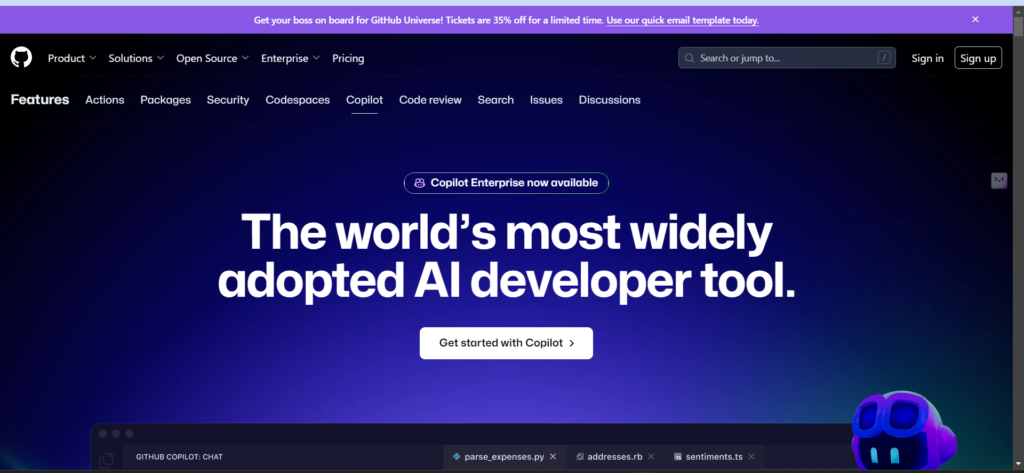
Purposes of GitHub Copilot is to streamline the coding process, allowing developers to focus more on problem-solving and less on syntax and boilerplate code. By offering intelligent autocompletion and real-time insights, it helps in minimizing errors and enhancing code quality. This tool is especially beneficial in complex coding environments where quick and accurate code generation can make a substantial difference in productivity.
GitHub Copilot operates at the intersection of cutting-edge artificial intelligence and software development, underpinned by OpenAI’s Codex model. Codex, a descendant of the renowned GPT-3 model, is designed specifically to generate and understand code. This model is trained on a vast corpus of both natural language and source code from publicly available repositories, enabling it to offer highly contextual and relevant code suggestions to developers.
The machine learning foundation of GitHub Copilot allows it to analyze the context within which a developer is working. By examining the preceding code and comments, Copilot can generate code snippets that align with the intended functionality.
This capability is powered by natural language processing (NLP), which helps the tool comprehend the intricacies of human language and programming syntax.
As a result, Copilot can suggest not only individual lines of code but also entire functions or even boilerplate templates for common coding tasks.
One of the standout features of GitHub Copilot is its ability to learn continuously from the vast array of public code repositories available on GitHub. This extensive training on diverse codebases ensures that Copilot can provide solutions that are not only syntactically correct but also follow best practices and are aligned with the coding styles prevalent in the developer community.
By leveraging this vast pool of knowledge, Copilot is able to offer code completions that are sophisticated and contextually accurate, significantly boosting productivity and reducing the time developers spend on routine coding tasks.
Features and Capabilities
1.Code completion
GitHub Copilot stands out as a premier AI coding assistant tool due to its array of advanced features and capabilities designed to enhance developer productivity. One of its most significant features is code completion. This functionality allows developers to write code faster by predicting and suggesting the next lines of code based on the current context. By understanding the patterns and structures within the code, GitHub Copilot can provide accurate and relevant suggestions, minimizing the time spent on routine coding tasks.
2.Snippet generation
Instead of manually typing out repetitive code blocks, developers can rely on Copilot to generate snippets that match the required functionality. This feature is particularly useful for boilerplate code, where the structure is often repeated across different parts of the project. By leveraging snippet generation, developers can maintain consistency and focus on more complex coding challenges.
Real-time suggestions are also a cornerstone of GitHub Copilot’s capabilities. As developers type, Copilot offers instant suggestions that can be quickly integrated into the codebase. This feature supports an iterative and interactive coding process, allowing for continuous refinement and improvement of the code. The ability to receive real-time feedback is invaluable, especially in fast-paced development environments where efficiency is key.
GitHub Copilot’s support for multiple programming languages further enhances its versatility. It is compatible with popular languages such as Python, JavaScript, TypeScript, Ruby, and Go, among others. This wide-ranging support ensures that developers working in various tech stacks can benefit from Copilot’s advanced features, making it an inclusive tool for diverse coding needs.
3.Natural language comments
One of the most impressive aspects of GitHub Copilot is its ability to understand natural language comments and translate them into functional code. Developers can write comments in plain English, and Copilot can interpret these comments to generate corresponding code snippets. This capability bridges the gap between human language and programming languages, streamlining the development process and reducing the cognitive load on developers.
GitHub Copilot’s combination of code completion, snippet generation, real-time suggestions, multi-language support, and natural language understanding positions it as the best AI coding assistant tool available today. Its comprehensive feature set empowers developers to code more efficiently, reducing repetitive tasks and allowing for greater focus on creative problem-solving.
Benefits for Developers
GitHub Copilot, an innovative AI-powered coding assistant, offers several significant benefits for developers, enhancing their productivity and coding efficiency. One of the primary advantages is the acceleration of the coding process. By providing instant code suggestions, Copilot allows developers to write code faster, reducing the time spent on mundane tasks and enabling them to focus on more complex problems. This feature is particularly beneficial when dealing with repetitive boilerplate code, as Copilot can automatically generate standard code patterns, alleviating the tedium of manual entry.
Another notable benefit is the reduction of syntax errors. GitHub Copilot’s advanced machine learning algorithms can predict the next lines of code with high accuracy, significantly diminishing the likelihood of syntax mistakes. This capability is invaluable for both novice and experienced developers. For beginners, it serves as an educational tool, offering real-time guidance and helping them understand coding conventions. For seasoned developers, it streamlines the debugging process and enhances code quality.
Moreover, GitHub Copilot is adept at learning and adapting to a developer’s unique coding style over time. This personalized approach leads to more relevant and context-aware suggestions, further improving coding speed and accuracy. As developers continue to use Copilot, the tool refines its recommendations, making it an increasingly effective assistant.
Collaborative coding is another area where GitHub Copilot excels. By promoting coding standards and consistency, it ensures that teams maintain a uniform codebase, which is essential for successful project collaboration. The AI assistant helps in adhering to best practices and guidelines, making it easier for multiple developers to work on the same project without encountering inconsistencies or integration issues.
GitHub Copilot stands out as an invaluable tool for developers, offering benefits that span increased productivity, reduced errors, personalized assistance, and improved collaboration. Its ability to enhance coding efficiency and maintain high standards makes it an essential asset for any development team.
Advantages
GitHub Copilot does face certain limitations and challenges that users must consider. One significant concern is the potential for over-reliance on AI-generated code. Developers might become dependent on Copilot’s suggestions, leading to a decline in their own coding skills and critical thinking abilities. It is essential to maintain a balance between using AI assistance and nurturing one’s own problem-solving capabilities.
User Experience and Integration
GitHub Copilot has been widely praised for its exceptional user experience and seamless integration with popular integrated development environments (IDEs), particularly Visual Studio Code. The installation process is straightforward, requiring only a few steps to get the extension up and running. Users simply need to install the GitHub Copilot extension from the Visual Studio Code marketplace, sign in with their GitHub credentials, and they are ready to start leveraging the power of this AI coding assistant.
Once installed, GitHub Copilot integrates smoothly into the developer’s workflow. It operates in the background, providing real-time code suggestions and autocompletions as the developer types. This non-intrusive approach ensures that the tool enhances productivity without causing distractions or disruptions. The suggestions appear within the IDE’s standard interface, making it easy for developers to accept, reject, or modify the proposed code snippets.
Feedback
Feedback from users highlights the intuitive nature of GitHub Copilot’s interface. Many developers appreciate how the tool anticipates their needs and offers contextually relevant suggestions. The AI-driven recommendations are not just limited to code completion but also include entire functions and complex algorithms, which can significantly speed up the coding process. Users have noted that Copilot’s ability to understand context and provide relevant suggestions improves over time, making it an increasingly valuable asset in their coding toolkit.
Overall, the user experience with GitHub Copilot is highly positive, with many developers finding it to be a game-changer in their coding practices. The tool’s seamless integration with Visual Studio Code and other IDEs, combined with its ease of installation and intuitive interface, makes it an indispensable assistant for both novice and experienced developers. The overwhelmingly positive user feedback underscores its effectiveness in enhancing coding efficiency and workflow integration.
while GitHub Copilot is an impressive AI coding assistant, it is not without its limitations and challenges. By recognizing these potential issues and maintaining diligent human oversight, developers can effectively leverage Copilot’s capabilities while mitigating risks and ensuring high-quality, secure, and ethically sound code.
Pricing

Comparing GitHub Copilot with Other AI Coding Tools
AI-powered coding assistants, several tools have garnered attention, including Kite, TabNine, and IntelliCode. Each of these tools brings distinct capabilities to the table, yet GitHub Copilot stands out due to its unique features and advantages.
Kite, for instance, utilizes machine learning to provide code completions and documentation lookup. While it supports several programming languages and integrates with popular code editors, its functionality is limited when compared to GitHub Copilot. Copilot, powered by OpenAI’s Codex, offers more sophisticated code completion, generating entire blocks of code, functions, and even complex algorithms based on natural language prompts. This not only enhances productivity but also reduces the time spent on boilerplate code.
well-regarded tool, leverages deep learning to suggest code completions. It is known for its extensive programming language support and capability to work offline. However, GitHub Copilot excels in contextual understanding, providing more relevant suggestions by comprehending the context of the code being written. This results in fewer irrelevant suggestions and a more streamlined coding experience.
IntelliCode, Microsoft’s AI assistant, integrates seamlessly with Visual Studio and Visual Studio Code. It offers intelligent code suggestions based on best practices derived from analyzing numerous open-source repositories. Despite its strong integration and reliable suggestions, GitHub Copilot surpasses IntelliCode by offering a broader range of functionalities. Copilot can generate complex code snippets, refactor code, and even help in learning new programming languages through its interactive prompts.
while tools like Kite, TabNine, and IntelliCode have their merits, GitHub Copilot’s advanced contextual understanding, comprehensive code generation capabilities, and strong user feedback make it the premier AI coding assistant tool in the market today.
The future prospects of AI in software development are both promising and transformative, with tools like GitHub Copilot serving as a compelling case study. As we look ahead, it is evident that AI coding assistants will likely evolve to become indispensable components of the development process. These tools are currently making significant strides in enhancing coding efficiency and fostering innovation, but their full potential is yet to be realized.
Ongoing research in the field of artificial intelligence is pioneering advancements that could further revolutionize how developers approach coding. One area of focus is improving the contextual understanding of AI models. Future iterations of AI coding assistants could possess a deeper comprehension of project-specific requirements, allowing for more accurate and contextually relevant code suggestions. This would not only save time but also minimize the likelihood of errors, leading to more robust and reliable software.
Another promising development is the integration of machine learning algorithms capable of learning from a wider array of coding styles and conventions. This would enable AI tools to adapt to individual developer preferences, creating a more personalized and efficient coding environment. Additionally, advancements in natural language processing (NLP) could facilitate more intuitive interactions between developers and AI assistants, making it easier to convey complex coding tasks and receive precise assistance.
The long-term impact of AI tools like GitHub Copilot on the software development industry could be profound. As these tools continue to evolve, they have the potential to democratize coding by lowering the barrier to entry for new developers. By automating routine and repetitive tasks, AI coding assistants could free up developers to focus on more creative and strategic aspects of their work, driving innovation and accelerating project timelines.
Moreover, the collaborative capabilities of AI could foster a more inclusive development environment, enabling teams to leverage diverse perspectives and expertise. As AI becomes more integrated into the development process, it could also pave the way for new methodologies and best practices, ultimately reshaping the landscape of software development.
2.Murf AI
Best for Multichannel Content Creation
Murf stands out as a leading AI voice generator, particularly noted for its exceptional versatility in multichannel content creation. One of Murf’s most impressive features is its extensive library of diverse voice options. These voices span various accents, tones, and styles, ensuring that content creators can find the perfect match for any project. Whether it’s an engaging podcast, an educational video, or a multilingual advertisement, Murf provides the necessary tools to make the content truly resonate with the audience.

Advantage
advantage of Murf is its robust language support. With the ability to generate speech in multiple languages, it caters to a global audience. This feature is particularly beneficial for brands and businesses aiming to reach international markets. The language support is complemented by high-quality, natural-sounding voices that enhance the overall user experience, making the content more engaging and effective.
Integration is seamless with Murf, thanks to its compatibility with various content creation tools. This includes popular platforms such as Adobe Premiere Pro, Audacity, and Final Cut Pro, among others. The ease of integration allows content creators to streamline their workflow, saving time and effort while still producing high-quality results. Murf’s user-friendly interface further simplifies the process, enabling even those with minimal technical expertise to create professional-grade audio content.
Pricing

Real-world use cases highlight the practical applications of Murf. For instance, educational institutions use Murf to develop interactive e-learning modules, while marketing agencies leverage its capabilities for creating compelling ad campaigns. Testimonials from content creators consistently praise Murf for its reliability and the quality of its output. One user noted, “Murf has transformed the way we produce content. The variety of voice options and the ease of integration with our existing tools have significantly improved our efficiency and the overall quality of our projects.”
Overall, Murf’s diverse voice options, extensive language support, and seamless integration capabilities make it an invaluable tool for multichannel content creation. Its real-world applications and positive user feedback further solidify its position as a top choice for AI voice generation in 2024.
3.Play.ht
Best for AI Voice Agents
Play.ht stands out in the realm of AI voice generators due to its specialization in creating sophisticated AI voice agents. Leveraging advanced text-to-speech technology, Play.ht ensures that the voices produced are not just clear, but also remarkably natural-sounding. This attribute is particularly beneficial for businesses aiming to enhance their customer service through realistic and engaging voice interactions.
One of the most noteworthy features of Play.ht is its extensive customization options. Users can tweak various aspects of the voice, such as pitch, speed, and tone, to align perfectly with their brand identity. This level of personalization allows companies to maintain consistent communication styles across different customer touchpoints.
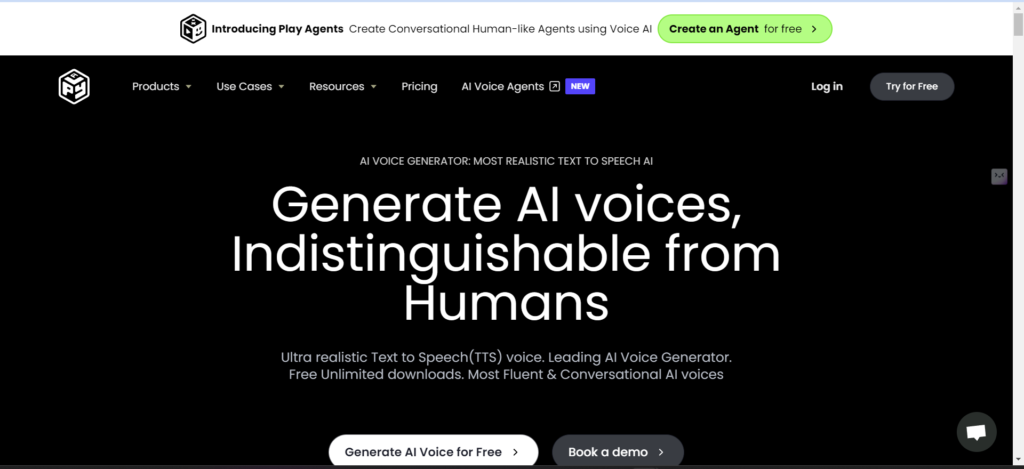
Play.ht offers seamless integration with various customer service platforms. Whether it’s for automated customer support, interactive voice response (IVR) systems, or virtual assistants, Play.ht’s AI voice agents can be easily incorporated into existing workflows. This integration capability not only simplifies deployment but also enhances the overall efficiency of customer service operations.
Several businesses have successfully utilized Play.ht to improve their customer interactions. For instance, e-commerce platforms have integrated Play.ht’s voice agents to assist customers with order tracking and product inquiries, resulting in quicker response times and higher customer satisfaction rates. Similarly, financial institutions have employed these AI voice agents to handle routine queries, allowing their human staff to focus on more complex issues.
Pricing
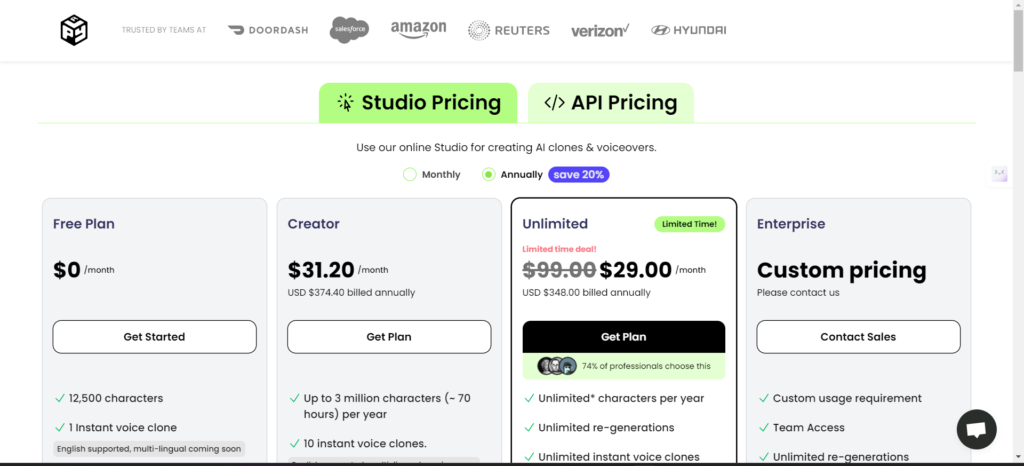
Play.ht’s proficiency in generating natural-sounding AI voices, combined with its robust customization features and easy integration, makes it an ideal choice for businesses looking to elevate their customer service experiences. By adopting Play.ht, companies can not only streamline their operations but also foster more meaningful and efficient interactions with their customers.
4.Lovo AI
Best Combined AI Voice and Video Platform
Lovo AI is a company based in Dubai that offers a variety of AI-powered solutions for various industries. Some of the solutions offered by Lovo AI include speech recognition, natural language processing, and computer vision. Lovo AI also provides customized AI services to meet the specific needs of its clients.

One of the key strengths of Lovo is its synchronization capability. The platform allows users to synchronize AI-generated voices with video content effortlessly, ensuring that the audio and visual elements are perfectly aligned. This is especially beneficial for marketing campaigns and e-learning modules where precise coordination between voice and video is crucial for effective communication.
Lovo also boasts a diverse range of voice styles, catering to various needs and preferences. Users can choose from multiple voice options, including different accents, tones, and speech patterns, to create content that resonates with their target audience. This variety ensures that users can find the perfect voice to match the mood and message of their project.
The user-friendly interface of Lovo further enhances its appeal. The platform is designed to facilitate a smooth user experience, allowing even beginners to create professional-quality voiceovers with ease. The straightforward process involves selecting the desired voice, inputting the text, and synchronizing it with the video, all within a few clicks.
Several case studies highlight Lovo’s effectiveness across different sectors. In marketing, Lovo’s AI voice generator has been used to create compelling advertisements that captivate audiences and drive engagement. E-learning platforms have leveraged Lovo to produce educational content with clear and engaging narration, enhancing the learning experience for students. Additionally, businesses have utilized Lovo for internal training videos, ensuring that information is communicated effectively and consistently. Overall, Lovo’s unique combination of AI voice and video capabilities, along with its diverse voice styles and user-friendly interface, makes it a top choice for those looking to elevate their multimedia projects.
When it comes to enterprise-level AI scalability, ElevenLabs stands out as a premier choice. Known for its advanced AI voice generation capabilities, ElevenLabs is specially designed to meet the high demands of large-scale operations. The platform excels in producing high-quality, natural-sounding voices that can be tailored to fit various business applications, from customer service automation to interactive training modules.
One of the key features of ElevenLabs is its ability to handle large-scale deployments seamlessly. Unlike smaller solutions that may falter under heavy usage, ElevenLabs’ infrastructure is built to scale, ensuring consistent performance even during peak times. This reliability is crucial for enterprises that depend on uninterrupted service to maintain customer satisfaction and operational efficiency.
Security is another area where ElevenLabs shines. The platform incorporates robust security measures to protect sensitive data, making it a trustworthy option for businesses that prioritize data integrity and compliance. With features such as end-to-end encryption and stringent access controls, ElevenLabs ensures that your data remains secure at all times.
Pricing

Several large enterprises have successfully implemented ElevenLabs’ solutions, showcasing its scalability and reliability. For instance, a global telecommunications company utilized ElevenLabs to revamp its customer support system, resulting in a 30% increase in customer satisfaction scores. Another example is a multinational e-learning provider that integrated ElevenLabs into its platform, significantly enhancing the interactive user experience for millions of learners worldwide.
ElevenLabs is an excellent choice for enterprises seeking a scalable, secure, and high-quality AI voice generation solution. Its ability to handle large-scale deployments without compromising performance or security makes it a reliable partner for businesses looking to leverage AI for enhanced operational efficiency and customer engagement.
5.Speechify
Speechify is a text-to-speech application or software that converts written text into spoken words. It offers a wide range of customization options, such as voice selection, speaking speed, and volume, to suit users’ preferences. Speechify can be used for various purposes, such as accessibility, language learning, and productivity, and is available on multiple platforms, including desktop and mobile devices.
Speechify also offers a free version and a paid version with extra features.
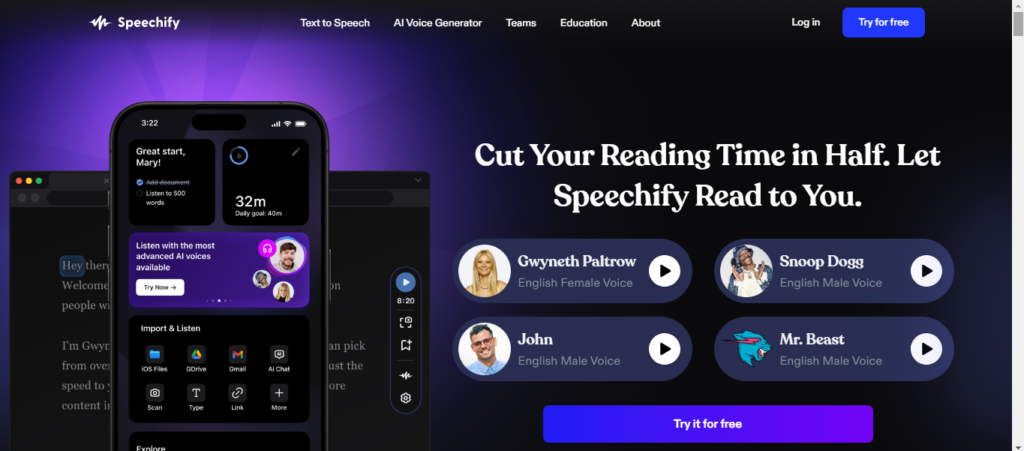
When it comes to AI-driven narration, Speechify stands out as a top contender. This platform offers a range of features that make it exceptionally versatile and effective for various narration projects. One of the key highlights of Speechify is its extensive library of voice options. Users can choose from a wide array of voices, each with unique tonal qualities and accents, ensuring that they find the perfect match for their specific needs.
Speechify’s natural intonation sets it apart from many other AI voice generators. The synthetic voices produced by this platform are remarkably lifelike, capturing the nuances of human speech in both pacing and emotion. This makes it particularly suitable for projects where the quality of narration is paramount, such as audiobooks and podcasts.
Adaptability is another strong suit of Speechify. The platform can be tailored to suit different types of narration projects, whether it’s delivering educational content, narrating novels, or producing professional podcasts. This flexibility is highly valued by users who require a reliable and consistent voice for various applications.
Testimonials from users further underscore Speechify’s effectiveness. One user, a podcaster, noted, “Speechify has transformed how I produce my episodes. The voices are so natural that my listeners often can’t tell the difference between human and AI narration.” Similarly, an educator who uses Speechify for creating audio lessons remarked, “The clarity and natural flow of the voices make the content more engaging for my students. It’s been a game-changer in my teaching methods.”
For those in the audiobook industry, Speechify has proven to be an invaluable tool. An author shared, “Using Speechify for my audiobook narration was a seamless experience. The intonation and variety of voices available allowed me to bring my characters to life in a way that resonated with my audience.”
Overall, Speechify’s specialization in AI narration, combined with its varied voice options and natural intonation, makes it an excellent choice for anyone looking to enhance their audio content.
Comparison of the Top AI Voice Generators
When evaluating the best AI voice generators available in 2024, several key parameters come into play. These include voice quality, ease of use, customization options, and pricing. Each of these factors is essential for users to consider in order to choose the right platform for their needs.
Voice Quality
Voice quality is arguably the most critical aspect of any AI voice generator. The top contenders in this space offer highly natural-sounding voices that can mimic human intonation and emotion. For instance, Platform A and Platform B excel in delivering high-fidelity audio, making them ideal for professional applications such as podcasts and audiobooks. On the other hand, Platform C, while offering solid voice quality, may not reach the same level of naturalness, making it more suitable for simpler tasks like automated customer service responses.
Ease of Use
Ease of use can significantly impact the overall user experience. Platforms like Platform D and Platform E are known for their intuitive interfaces, allowing even less tech-savvy users to generate high-quality voice outputs with minimal effort. Conversely, Platform C, although powerful, has a steeper learning curve that might deter beginners but could be a perfect fit for advanced users seeking more control.
Customization Options
Customization options are another crucial factor. Platform A and Platform D offer extensive customization features, enabling users to tweak various aspects of the voice output, such as speed, pitch, and tone. This flexibility is particularly beneficial for content creators who require a unique voice signature. Platform B, while offering fewer customization options, compensates with a broad range of pre-set voices that cater to different needs.
Pricing
Pricing is often the deciding factor for many users. Platform E stands out for its competitive pricing plans that offer great value for money without compromising on quality. Platform A and Platform B, while more expensive, justify their higher price tags with superior voice quality and advanced features. Platform C provides a middle-ground option, balancing cost and functionality, whereas Platform D’s pricing is on the higher side but is justified by its extensive customization capabilities.
In conclusion, each AI voice generator has its strengths and limitations. By considering factors like voice quality, ease of use, customization options, and pricing, users can make an informed decision that best suits their specific requirements.
In this exploration of the top five AI voice generators of 2024, we’ve delved into the standout features and unique strengths of each tool. From Google Cloud Text-to-Speech’s unparalleled customization options to Amazon Polly’s seamless integration capabilities, each AI text-to-speech solution offers distinct advantages tailored to various user needs.
IBM Watson Text-to-Speech stands out with its advanced neural voices and adaptability, while Microsoft Azure Text-to-Speech impresses with its diverse language support and natural-sounding output. Finally, iSpeech Text-to-Speech distinguishes itself with its user-friendly interface and robust API support.
The advancements in AI voice generation technology are not only transforming the way we interact with digital content but are also paving the way for innovative applications across multiple industries. From enhancing accessibility for individuals with disabilities to revolutionizing customer service and educational tools, the impact of AI text-to-speech is far-reaching.
As AI continues to evolve, we can expect even more refined and lifelike synthetic voices, further blurring the line between human and machine interaction. This progress promises to unlock new possibilities and efficiencies, making AI voice generators an indispensable tool in our digital toolkit.
We encourage you to explore these AI voice generators to determine which one best aligns with your specific requirements. Whether you’re a developer, content creator, educator, or business professional, there’s an AI text-to-speech solution out there that can enhance your projects and streamline your workflows. Embrace the future of voice technology and discover the transformative potential of AI-driven speech synthesis.
Read also: 10 Best AI Image Generators

